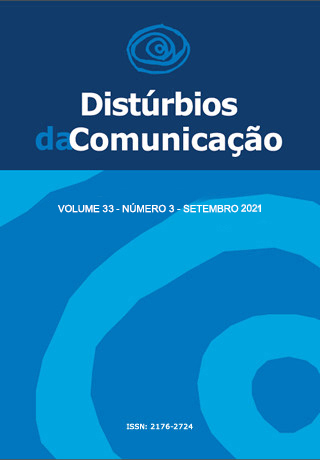Infants Hearing Assessment process after referring newborn hearing screening
DOI:
https://doi.org/10.23925/2176-2724.2021v33i3p416-427Keywords:
Diagnosis, Neonatal Screening, Lost to Follow-up, Hearing, Hearing Loss, NewbornAbstract
Introduction: Hearing assessment is essential until the third month of life in order to enable early intervention, allowing the child’s proper speech and language development. Nevertheless, this process faces several barriers that may delay its conclusion. Purpose: To investigate aspects in the hearing assessment process in infants who refers newborn hearing screening (NHS), describing the age at which screening and diagnosis were performed, the reasons for evasion or loss to follow up, and reasons for missing appointments during the process, reasons for delay in completing the diagnosis, and the audiological results of those who completed this process. Methods: This is a quantitative, descriptive, and observational study that was carried out at a hearing health center in São Paulo. The study analyzed 68 medical records from children who referred NHS, born in São Paulo city maternity hospitals, and then referred to a hearing health center, from January to June 2019. Data were analyzed based on the quality criteria established by national and international committees. Results: There was an adherence lower than expected for hearing assessment (76.5%); contact with parents using mobile phones, after missing the appointments, was not efficient (75%). NICU stay for more than five days was the most common risk indicator (25%). Half of the children analyzed process completed the diagnosis, 42.2% of the children were still in the process, and 7.7% were lost in the process. Most of the children who completed the diagnosis had some type and degree of hearing loss (65.4%). Conclusion: Although NHS is being performed as expected in more than 95% of the newborns, hearing assessment is not being completed in more than 90% of the children who referred NHS. New strategies are needed in order to reduce loss to follow-up in the hearing assessment process.
Downloads
References
JCIH. Year 2007 Position statement: principles and guidelines for early hearing detection and intervention programs. Pediatr Rev. 2007; 120(4): 898-921.
Lewis DR, Marone SAM, Mendes BCA, Cruz OLM, Nóbrega M. Comitê Multiprofissional em Saúde Auditiva – COMUSA. Braz J Otorhinolaryngol. 2010; 76(1): 121-8.
JCIH. Year 2019 Position Statement: Principles and Guidelines for Early Hearing Detection and Intervention Programs. J Early Hear Detect Interv. 2019; 120(4): 898-921.
Brasil. Lei Federal n° 12.303, de 2 de agosto de 2010. Dispõe sobre a obrigatoriedade de realização do exame denominado Emissões Otoacústicas Evocadas. Diário Oficial da República Federativa do Brasil. 2 ago 2010 [acesso em 27 jul. 2020] Disponível em: http://www.planalto.gov.br/ccivil_03/_Ato2007-2010/2010/Lei/L12303.htm.
Alvarenga K F. Avaliação audiológica em bebês 0 a 1 ano de idade. In: Academia Brasileira de Audiologia. Tratado de Audiologia. 2. ed. Rio de Janeiro: Editora Guanabara Koogan. 2015; 31: 517-29.
Silva ARA, Silveira AK, Curado NRPV, Muniz LF, Griz SMS. Acompanhamento em programas de saúde auditiva infantil: uma revisão integrativa. Rev CEFAC. 2014; 16(3): 992-1003.
Subbiah K, Mason CA, Gaffney M, Grosse SD. Progress in Documented Early Identification and Intervention for Deaf and hard of Hearing Infants: CDC’s Hearing Screening and Follow-up Survey, United States, 2006-2016. J Early Hear Detect Interv. 2018; 3(2): 1-7.
Newborn Hearing Screening. ASHA. Disponível em: https://www.asha.org/practice-portal/professional-issues/newborn-hearing-screening/
Luz IM, Ribas A. Triagem Auditiva Neonatal em uma maternidade pública de Curitiba-PR: Fatores determinantes para a não adesão ao reteste. [dissertação]. Curitiba: Universidade Tuiuti do Paraná, 2014.
Moura RP, De Resende LM, Carvalho ASA, Anchieta, LM. Avaliação da implementação de um protocolo de triagem auditiva neonatal específica para crianças com indicadores de risco em uma maternidade de Minas Gerais. Rev Med Minas Gerais. 2015; 25(2): 224-32.
Fitzpatrick EM, dos Santos JC, Grandpierre V, Whittingham J. Exploring reasons for late identification of children with early-onset hearing loss. Int J Pediatr Otorhinolaryngol.2017; 100: 160-7.
Januário GC, et al. Quality indicators in a newborn hearing screening service. Braz J Otorhinolaryngol. 2015; 81(3): 255-63
Donabedian A. The Role of Outcomes in Quality Assessment and Assurance. Qual Rev Bull. 1992; 18(11): 356-60.
Crouch E, Probst J, Bennett K, Carroll T. Evaluating Loss to Follow-up in Newborn Hearing Screening in a Southern State. J Early Hear Detect Interv. 2017; 2(1): 40-7.
Carneiro CS, Pereira MCCS, Lago MRR. Monitoramento audiológico em bebês com Indicadores para Deficiência Auditiva. Distúrb Comun. 2016; 28(3): 512-22.
Fichino SN, Avelino VLF, Lewis DR. Características demográficas e audiológicas da população pediátrica de um centro de referência em saúde auditiva de São Paulo. Distúrb Comum. 2018; 30(3): 570-84.
Wang CH, et al. Prevalence and independent risk factors for hearing impairment among very low bith weight infants. Int J Pediatr Otorhinolaryngol. 2017; 93: 123-7.
Downloads
Published
Issue
Section
License
Copyright (c) 2021 Marcela Bastos Galvão, Silvia Nápole Fichino, Doris Ruthy Lewis

This work is licensed under a Creative Commons Attribution 4.0 International License.









